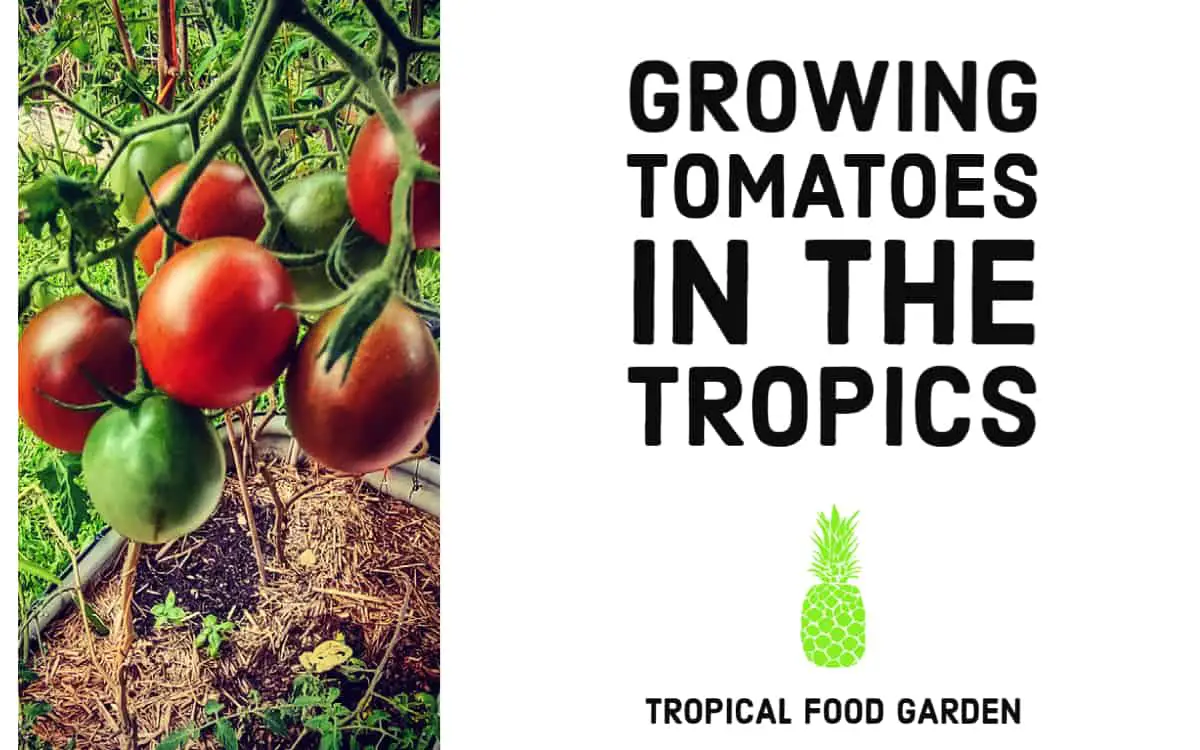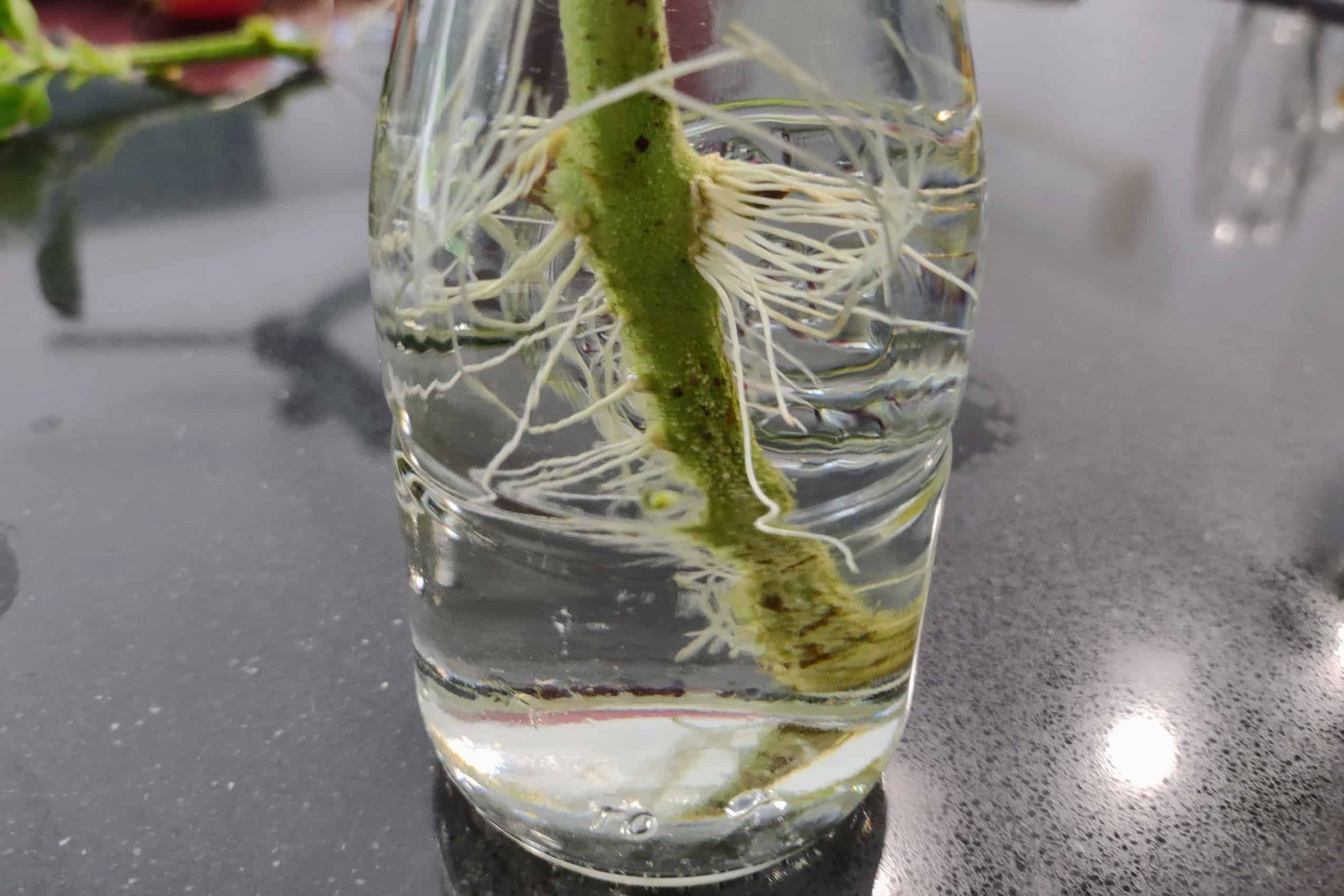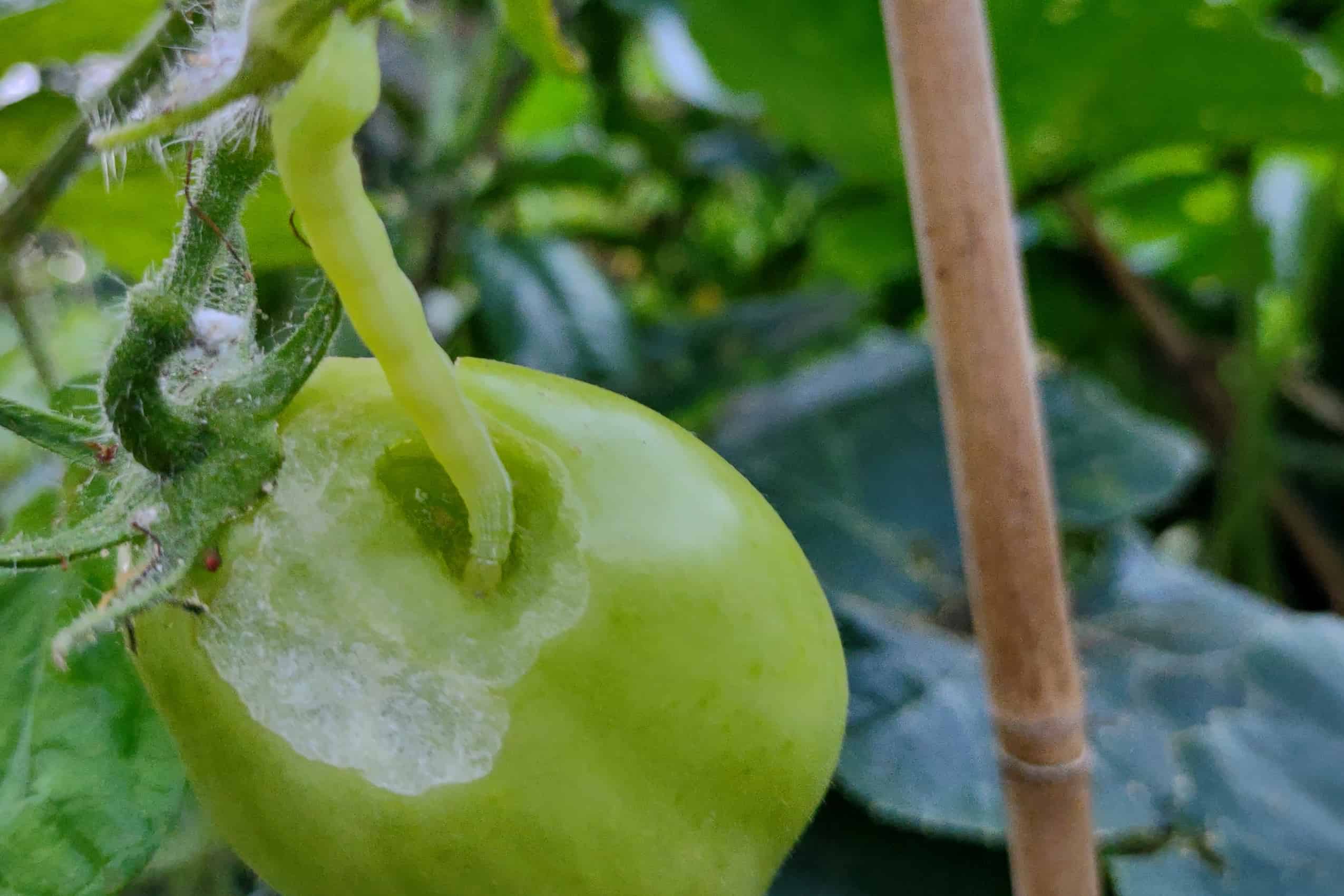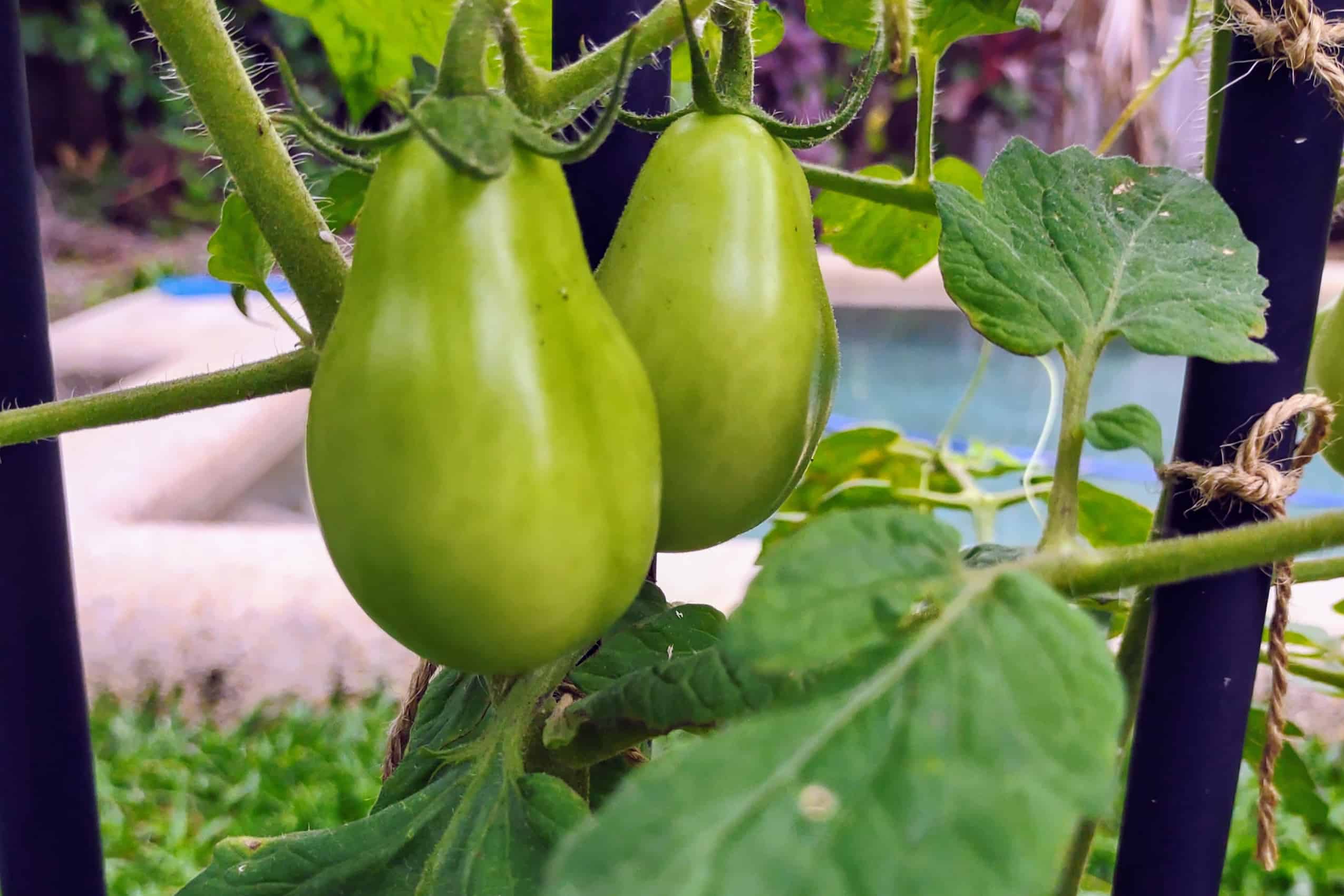This post may contain affiliate links.
This post is about my experience and things I’ve learned growing tomatoes in the tropics. Yes, of course you can grow tomatoes in the tropics, but it’s a little different to growing cherry, heirloom, grape, beefsteak and slicer tomatoes in more temperate climates. I grew up growing tomatoes in a temperate environment, where winters didn’t support tomato growing. In the tropics you can grow tomato plants all year round, just about, and they’ll grow as perennials endlessly giving you cuttings for new plants. It’s not totally easy and some times of year are better for growing tomatoes than others, but here are a few tips and tricks for growing, planting, and sewing tomatoes in a hot country in summer and winter, wet monsoon season and dry season.

Growing Tomatoes in The Tropics
Should You Plant Seeds or Buy Tomato Plants?
Either is absolutely fine but seeds will give you dozens of plants for the cost of one larger plant from the garden centre or nursery. Tomatoes actually like to be transplanted and sunk into their permanent home deeper, so we don’t worry too much about transplantation shock with tomatoes. But why not get your tomato plants for free?
I find when buying seed that it’s best to buy online from a specialist seed vendor. Seeds from supermarkets have a tendency to not germinate sometimes. But, if they’re all you can get, grow them. Work with what you’ve got, always.
How To Get Tomato Plants For Free

Do you have tomatoes in your fridge? Take the seeds and plant them. You never know, some might grow. Some people dry them and ferment the jelly off but in my experience, they grow straight from the fruit. You’d be amazed how many plants you can grow for free from store-bought food.
Alternatively, do you have a friend or neighbour who grows tomatoes? Ask very nicely for a cutting and they may be able to give you a few. You see, most tomatoes need pruning. They tend to throw out side shoots from their “armpits” that most gardeners will remove to keep the plant more open. These side shoots root really easily if you pop them in a jam jar of water for a few days.
Once you see some nice roots forming just pot them up, nice and deep. Keep them out of direct sun for a few days until those roots get a grip and are able to take up as much water as your newly propagated tomato plants will need in the heat.
What time of Year To Plant Tomatoes in The Tropics?
Now is a good time. Now is always a good time. If you have seeds, plants, or cuttings, just plant them up and nurture them. For sure, some times are better than others. Check the date from sewing to first fruit on your seed packet. Aim to plant the seeds so that masses of fruit will be ripening in early spring into early summer. The time from sewing to fruiting for tomato plants is in the region of 60 to 80 days. This time varies with the variety of tomato.
Tomato plants don’t like temperatures much higher than 30C, 85F, so if your area of the tropics gets those sort of temperatures you’ll struggle, thankfully, we don’t very often. Our best times for tomatoes are the cooler months. Tomatoes also don’t like temperatures under 10C, 50F. We never used to get temperatures that low in our old location. On our new farm, we can see 5C in winter. Both locations are in the tropics, but the way I’m used to growing tomatoes is going to have to change.
Where in the tropics do you live? Our old home just 16 degrees from the equator allowed us to germinate tomato seeds and grow tomato plants year-round. Our new home, in the same tropical location, but at a greater elevation, is cooler. Germinating tomato seeds needs some extra warmth in winter and although the tomato plants grow and set some fruit through winter, they really start to thrive and produce masses of fruit in early spring.
Scorching dry season heat and lack of rain will make your tomato’s life harder, monsoon deluges likewise, but I’ve had success growing tomatoes from seeds, cuttings, and starts at just about any time of year in a hot tropical environment at sea level.
Throw the rules out the window, just grow them. As I said already tomatoes often grow as perennials in the tropics, I have tomato plants that are three years old and many are clones from cuttings so, technically, the same plant.
The easiest times to grow tomatoes would be the less extreme times of year, not too hot, not too wet, not too dry, not at the coldest time of year.
I get my best tomato harvest in July, August and September, usually. Our tropical winter here never gets so cold that tomato seeds refuse to germinate. (Until moving to a property at a greater elevation, where temperatures dropped significantly). September is technically the first month of spring here.
What’s the “Official” Best Time to Plant Tomato Seeds in Tropical Australia?
At the end of summer, once the wet season has done its worst is the time most gardeners recommend planting tomato seeds in the tropics. The best months to sew tomato seeds are April and May. (in Australia, or the Southern Hemisphere)
Tomato seedlings should then be planted out 4-6 weeks later, in June and July.
Look at your seed packet to find how many weeks later your variety of tomato produces fruit.
Tomatoes like growing during the cooler months in a tropical climate, but if you can give them some shade and protection from the heat and the wet, I’ve had moderate success year-round. Cherry tomatoes seem to be the easiest to grow.
I haven’t bought tomatoes at the store in over 2 years. That goes for tinned tomatoes for cooking too.
What Varieties of Tomato Can You Grow in The Tropics?
I’ve not yet found one I couldn’t grow. At first, I had more success with cherry tomatoes than larger varieties but as my tomato handling expertise grew (particularly my soil know-how) I found that really I could grow anything.
My favourites and most productive varieties are roma (plum) tomatoes for cooking, black Russian, a slicer, for just being beautiful and impressive, black grape, a nice purple cherry and a nameless random cherry that’s been giving us abundant food for years. I have no idea what variety it is nor where it came from.
A new one I’m growing this year is a pineapple tomato, these are delicious, large, yellow/peach tomatoes. They’re not massively productive as yet but each fruit is a treasure.
How To Look After Your Tomato Plants

Plants need sunshine, water, nutrients, and good soil. Good soil contains microorganisms, fungi, worms, and decaying matter, it holds moisture well. Really, gardening is all about growing good soil.
You’ll hear talk of tomatoes needing specific nutrients, potassium, nitrogen, calcium, and so on. And what about dolomite, blood and bone, and fish emulsion? Relax, it’s not hard and nothing to be scared of.
Keep your soil moist. This might mean you have to water them twice a day when it’s hot and dry, it might mean never in the wet season. Just keep the soil moist.
Don’t ever water plants in full sun if you can help it, and try not to splash water on leaves in the sun, this can burn them.
Wilting is normal, it’s the plant’s natural defence against dehydration, but if your plant goes beyond a mild wilt it could die. We don’t want that. Also, tomatoes don’t like to be sopping wet. Mine mostly survive the wet season, but they don’t like it. I raise mine in pots or raised beds so that they’re not sitting in a puddle for weeks.
Plants need a mixture of all the nutrients and minerals, just as we do. The following four elements are important in growing tomatoes.
- Nitrogen grows plants, it grows big, healthy leaves and stems. Nitrogen is the building block of amino acids and proteins. Niotrogen is found in well rotted organic matter, manure, compost, and very dilute urine.
- Potassium helps fruit and flowers grow. It facilitates transport within plants.
- Phosphorous is needed for photosynthesis, respiration, and growth
- Magnesium. Did you wonder why gardeners put Epson Salts in their garden beds? Plants need it. Yellowing can be caused by lack of Mg.
- Calcium prevents bottom (AKA blossom) end rot. I add dolomite to prevent this.

Tomatoes will also need support. Flimsy tomato cages are useless, don’t buy those. Tomato plants can get absolutely enormous, higher than the house, so they will need support.
I use canes (longer the better) and string and I’m experimenting with growing them up strings. However, my favourite tactic is to plant determinate tomatoes (like romas) rather than indeterminate, they’re just more manageable.
Some of the indeterminate cherries sprawl on and on. I have to keep cutting them back to size. Where a tomato stem touches the ground it will likely root in moist humid conditions, this is how they would grow if they were still wild. If your fruit is too low it can rot and, often, be eaten by rats and mice. I wish my cats could go outdoors to help with that!
Most gardeners prune their tomato plants, nipping out side shoots from the “armpits”. Some will prune them to a single stem and take off all old yellowing and browning leaves. It depends on how seriously you’re taking it really. Pruned or not, you’re likely to get some tomatoes to harvest. Not pruning the plants gives pests and diseases more places to hide out and grow. Watch out for bugs and caterpillars, check your plants daily. Squish bugs or brush them into a bucket of soapy water. I don’t like to use pesticides or DE that could harm my bees.
Every year you grow tomatoes you will become better at it. Watch, learn, observe, grow your tomato growing super powers.
New Plants Need To Be Looked After More
Young plants, seedlings, and newly rooted cuttings are like babies and you have to nurture them. Whether they form nuts, vegetables, or fruits. They won’t yet have a robust root system to access all that water and all those nutrients. They might have a lot more green than they do root. This will make them much more likely to dehydrate in the heat. Keep a close eye on them. Maybe keep them out of the sun when it’s very hot or move them undercover in torrential rain. This is easy in pots.
Generally, the bigger the pot and the better the soil or compost it contains, the more fabulous your tomatoes will be. Keep their soil moist but not soggy. Some people pinch off the first flowers so that the second bunch of blossoms will be on a stronger plant. I don’t, I’m always far too excited about the prospect of tomatoes. You see, there really is no 100% right way and wrong way. You don’t have to grow tomatoes the perfect way, just do what works.
At What Time Of Year Will Your Tomatoes Bear Fruit
I don’t think I’ve yet had a month with no tomatoes. They struggle in the wet, but still, there are usually a few.
My most productive time for tomato harvesting is after the wet season, to the start of the wet season. Any time but the wet season!
Optimum time seems to be about May onwards, our autumn into winter and spring. My tomatoes, just 16 degrees south of the equator, don’t like the hot, wet, humid summers at all. Pests are a major issue for me and my tomatoes in the wet. But I obstinately refuse to use pesticides or anything artificial on my garden. My best and only bug defense is squishing.
Tomatoes will struggle in the dry season if their soil is not good and you don’t keep them consistently damp. In very dry conditions I need to water morning and evening and a thick layer of mulch helps water retention. Good soil, that holds water and contains plenty of organic matter will help tomato plants thrive in the dry season. Some shade won’t hurt them either.
Bacterial Wilt and Tropical Tomatoes
If your tomato plants seem to be going well, producing flowers and setting fruit, looking green and healthy and then one day they wilt from the top. Watering doesn’t help, or they’re not dry. They wilt more, they are more than likely suffering from bacterial wilt.
For 3 years I grew tomatoes like a champ, no bacterial wilt issues, no nematode (tomato root-knot nematodes) problems. I hadn’t bought tomatoes for 3 years. And then we moved to our new farm or homestead. My tomato plants die.
We have bacterial wilt in our soil and there’s not much I can do about it. Bacterial wilt can also affect aubergines (eggplants), peppers (capsicum) and chillies. My chillies are doing fine as are my Asian-variety eggplants, but my tomatoes and capsicums died.
The only thing to do if you have bacterial wilt in your soil (as far as I know), is to start over with bought compost, clean pots, and new plants. The roots of the tomato plants will grow down into the soil if they can, so you’ll need to set your pot on a hard surface away from soil.
I’m having to start over, in late spring, not the best time, but I’ll let you know how it goes. The only tomatoes that seem unaffected by bacterial wilt are tiny spooner tomatoes, they grow wild in my tropical location and often arrive as volunteers, but they’re not the tomatoes we want.
I will not be defeated! Read up on bacterial wilt here.
What To Do With All Those Tomatoes?
Any tomatoes that we don’t eat fresh and raw, on the day, I cook or freeze to use later. I don’t do canning or bottling because we don’t have a winter to get through.
I simply chop my tomatoes in half or dice them smaller, and throw them in a bag in the freezer. I can add to, or take tomatoes from that bag day by day.
These are the reusable silicone freezer bags I use for all my garden produce. They’re a solid investment. Reusable plastic bags generally don’t last long. The stand that comes with these bags is invaluable for washing and drying and I put these in the dishwasher with no problems.
You can freeze cherry tomatoes, plum, salad, or beefsteak for cooking. They all freeze just fine.
Tomatoes freeze well for cooking. I can then use them to make any tomato-based sauce, soup, or casserole. I do not remove the skins as for a smooth tomato sauce (for pizza or pasta) I run them through the blender once cooked. It’s amazing how much garden produce you can freeze, I often have bags of bananas, aubergines, peppers, and chopped chilly peppers frozen too.
We also ferment, and dry. Both are possible with tomatoes and a few tomatoes in a fermented chilly sauce (hot sauce) is a great addition!
I’ve been sharing photos of my garden to Instagram for a few years now, I can easily look back and say yes, on that day last year I was picking tomatoes. I need to go back and check. Sometimes I even share daily harvest photos. Today it is mid-May, my main tomato harvest time is just beginning and things are looking really exciting out there, but also I’m starting new tomato plants from seed and cuttings. They should also be fine. As with every post on this site, this one will evolve, grow, and bloom. This is my hobby, my notes, my know-how. I am a scientist by training, a biologist actually. I experiment, test, and make notes. Welcome to my notebook.
great article, I live in Mackay, Queensland, so have a very similar situation, was good to read your opinions on growing, thanks, kev
we live in Honduras only problem I’ve noticed in the rainy season the tomatoes don’t like all that rain and it is on a raised bed. so I place a portable plastic tent like that of a greenhouse over them to shield the rain and seems to work well.
Yep, perfect! Mine are mostly under cover in the wet season, either in pots or in the ground, but we’re on a slope so the ground doesn’t get too saturated.
I live in Darwin NT and had a great first year crop. The next year was a waste of time and effort so last year I thought to grow in pots. Potting mix was full of curl grub larvae so lost half of my seedlings. The rest got some sort of leaf wilt and lots of grubs in the tomatoes themselves.
The most prolific were the small cherry tomatoes grown in a pot on the concrete. The temperature runs at 35-36 nowadays making it hard to set flowers. Have just purchased some Thai pink cherry tomato seeds. I am going to leave seeding them until into the new year and then do like you said, get new pots, change where I get my potting mix from and grow them on the concrete and see how they go. I might sneak some into the garden bed and see what happens. Have given up on growing table tomatoes.
Kate, I had amazing large slicer tomatoes this year, I think they were black russians, but by summer they’d all died. Those were in fresh clean soil in a raised bed with a dead chicken in there. Then we had a good flush of the tiny spooner tomatoes, again summer heat saw them off. But some of those little ones are coming in again now. If they’re in the shade they’ll last longer. Ours sprouted outside the stables in full afternoon sun, that clump died first, but it’s coming back up again now. Other types of tomato, like the little yellow cherries, the plants just die. I’m having a terrible time with pests. We’re in a new house, in the old house they grew fabulously, in the new house its incredibly diificult with grubs, nematodes, viruses, and all of my animals that seem determined to destroy everything I plant. Now its cooling down I’ll get some more in, but with old soil I doubt they’ll work. I think we’re just going to give up. I won’t use pesticides.